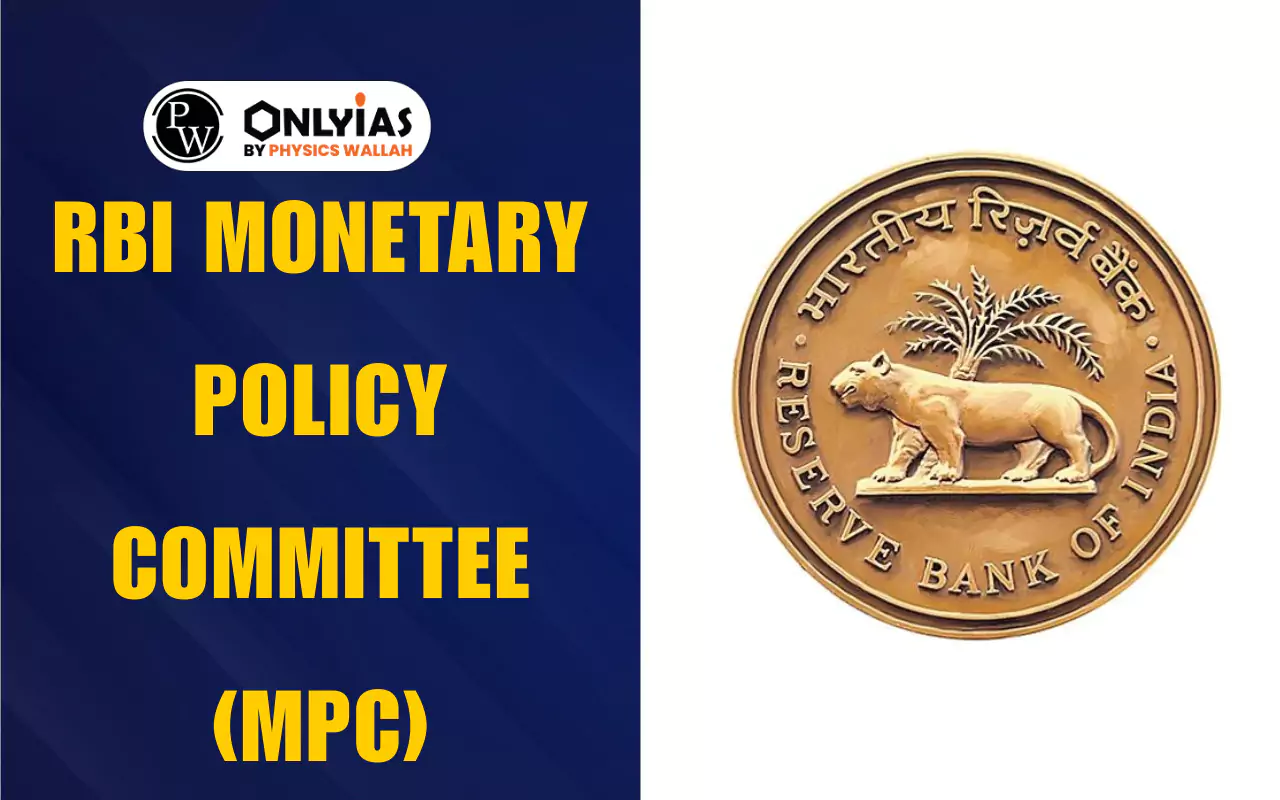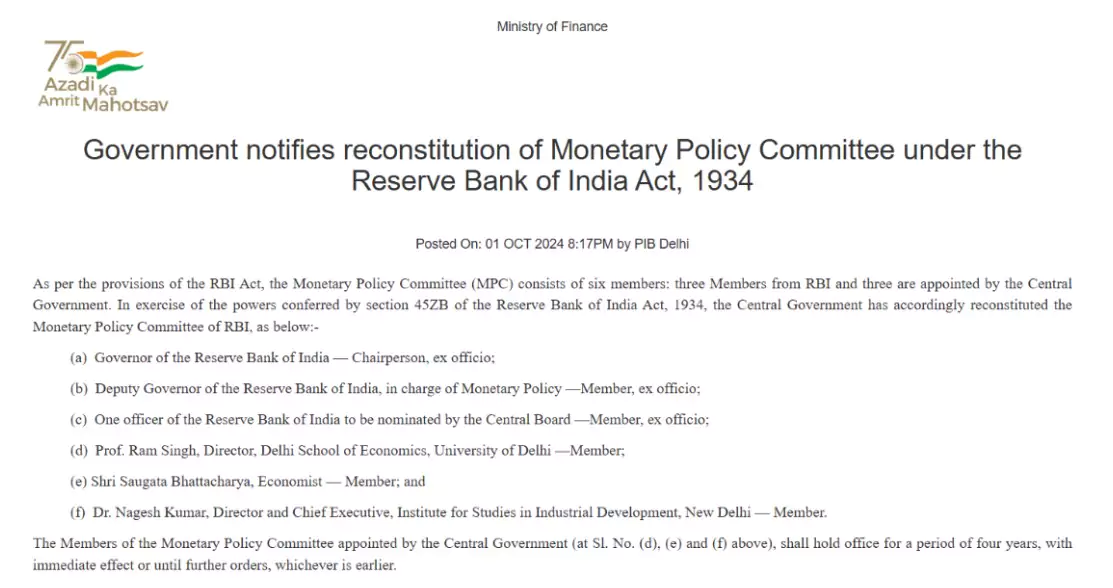RBI Monetary Policy Committee sets key interest rates to control inflation and support growth. RBI Monetary Policy Committee decisions guide banks, businesses, and the economy effectively.

RBI Monetary Policy Committee (MPC) is a 6-member body formed in 2016 to decide repo rates and control inflation while supporting growth. In Oct 2025, it kept repo rate at 5.5%, raised GDP forecast to 6.8%, and lowered inflation outlook to 2.6%. MPC ensures price stability, transparency, and balanced economic growth.
RBI Monetary Policy Committee: The Reserve Bank of India Monetary Policy Committee (often just called the RBI MPC) is very important for India’s economy. It helps in making decisions about interest rates and inflation control. The main aim of the committee is to keep prices stable and support economic growth. This body was created to make sure that decisions about money and credit are taken in a structured and transparent way.
In recent years, the Reserve Bank of India Monetary Policy Committee has become central to how the Indian economy is managed. It makes decisions that affect banks, businesses, and common people. For example, the lending rate of banks depends on the repo rate decided by the committee. This affects loans, EMIs, and even the savings of people.
The latest RBI MPC meeting 2025 shows how important this committee is in responding to global risks like tariffs and domestic challenges like inflation. To understand it better, below, we’ve mentioned its highlights, structure, objectives, functions, and powers.
The RBI MPC meeting 2025 was held in October. The committee decided to keep the repo rate unchanged at 5.5%. This was done because inflation is low, but growth faces risks due to tariffs from other countries.
Some key highlights include:
|
RBI Monetary Policy Committee Meeting 2025 Highlights |
|
| Key Point |
Details |
| 1. Repo rate unchanged | Repo rate kept steady at 5.50% for the second time in a row. Governor Sanjay Malhotra cited concerns over tariff uncertainties (possible new taxes or fees on imports/exports) that may slow growth. |
| 2. Higher GDP growth forecast | RBI revised GDP growth forecast to 6.8% from 6.5%, reflecting stronger expectations for India’s economic performance. |
| 3. Lower inflation outlook | Headline inflation revised down to 2.6%. With the RBI’s target of 4% (±2%), the softer inflation outlook gives room for future policy flexibility. |
| 4. Tariff warning | The governor warned that tariff-related issues may slow economic growth in the second half of the year. This will be closely monitored for future policy actions. |
RBI Monetary Policy Committee is a group of six members formed under the Reserve Bank of India Act, 1934. Its task is to set the policy interest rate, known as the repo rate. The repo rate is the rate at which the RBI lends money to commercial banks.
The main goal of this committee is to keep inflation under control while supporting economic growth. Earlier, the RBI Governor used to take such decisions. But to make the process more transparent and balanced, the committee was formed in 2016.
RBI MPC full form is Reserve Bank of India Monetary Policy Committee. This is a statutory body created by law. Every word in the full form has a clear meaning:
Monetary Policy Committee (MPC) of the Reserve Bank of India is constituted under the RBI Act, 1934. It includes three members from the RBI and three members nominated by the Central Government. The Governor of RBI serves as the Chairperson.
| RBI Monetary Policy Committee Members | ||
| Member | Role/Designation | Appointment Type |
| Sanjay Malhotra | Governor, RBI — Chairperson (ex officio) | RBI |
| Deputy Governor (Monetary Policy) | Member (ex officio) | RBI |
| One Officer of RBI nominated by the Central Board | Member (ex officio) | RBI |
| Prof. Ram Singh | Director, Delhi School of Economics, University of Delhi | Central Govt. Nominee |
| Shri Saugata Bhattacharya | Economist | Central Govt. Nominee |
| Dr. Nagesh Kumar | Director & CEO, Institute for Studies in Industrial Development, New Delhi | Central Govt. Nominee |
The three members nominated by the Central Government hold office for four years or until further notice.

Monetary Policy Committee chairman is always the Governor of the Reserve Bank of India. At present, the chairperson is Sanjay Malhotra. The chairman leads the discussions and has a casting vote in case of a tie. This means if votes are equal, the chairman’s vote decides the final outcome.
Many people get confused about the RBI Monetary Policy Committee (MPC) with the RBI Monetary Policy, but they are different. The MPC is the team that makes decisions, but on the other hand, the Monetary Policy is the set of actions that are taken based on those decisions.
| RBI Monetary Policy Committee vs RBI Monetary Policy | ||
| Feature | RBI Monetary Policy Committee (RBI MPC) | RBI Monetary Policy |
| Definition | The RBI Monetary Policy Committee is a six-member panel that decides the key policy interest rates, such as the repo rate. | RBI Monetary Policy refers to the rules, guidelines, and measures implemented by RBI to manage money supply, inflation, and economic growth. |
| Purpose | To analyze economic data and decide how to maintain stable prices and support growth. | To control inflation, ensure financial stability, and support economic growth. |
| Decision Making | The committee meets at least four times a year and votes on key interest rates and other measures. | Policies are executed based on the decisions of the RBI MPC and other RBI objectives. |
| Members/Composition | Six members: three from RBI (including the Governor and Deputy Governor) and three nominated by the Central Government. | It is not applicable. This is the set of actions, and not a group of people. |
| Example of Action | The MPC decides to keep the repo rate at 5.50% during the October 2025 meeting. | RBI lowers or raises the interest rates, adjusts liquidity, or implements measures like cash reserve ratio changes. |
| Focus | Decision-making body that analyzes economic risks and growth trends. | Practical implementation of those decisions in the economy. |
The main goal of the RBI Monetary Policy Committee (MPC) is to keep India’s economy stable and growing. Below, we’ve mentioned the objective of RBI Monetary Policy Committee:
Keep Prices Stable: The MPC works to stop prices from rising too fast. This makes it easier for people and businesses to plan their spending.
Help the Economy Grow: While keeping prices stable, the committee also makes sure the economy grows. This helps businesses, creates jobs, and encourages investment.
Make Clear Decisions: The MPC makes decisions that are clear and based on facts. This helps people trust the economy and the markets.
Build Confidence: By making steady and predictable decisions, the MPC helps investors, businesses, and citizens feel confident about the economy.
Balance Prices and Growth: The committee makes sure prices don’t rise too fast and that the economy keeps growing steadily.
RBI Monetary Policy Committee (MPC) has clear roles and powers to manage the economy. Below, we’ve mentioned the functions and powers of the RBI MPC:
| RBI MPC Functions and Powers | |
| Function / Power | Description |
| Fixing the Repo Rate | The MPC decides the repo rate, which is the interest rate at which banks borrow from the RBI. This affects loans, EMIs, and savings rates for people and businesses. |
| Ensuring Inflation Targets | The government sets an inflation target of 4% with a 2% margin on either side. The MPC works to keep prices stable within this range to protect purchasing power. |
| Holding Regular Meetings | The committee meets at least four times a year to review the economy and decide on monetary measures based on the latest data. |
| Making Collective Decisions | Every member of the MPC has one vote. Decisions are taken by majority vote, and in case of a tie, the Governor has the casting vote. |
| Publishing Policy Statements | After each meeting, the MPC publishes a report explaining its decisions, the reasoning behind them, and the economic outlook for the coming months. |
RBI Monetary Policy Committee (MPC) uses many instruments to control inflation, manage liquidity, and support economic growth.
| Instruments used by the RBI MPC | |
| Instrument | Description |
| Repo Rate | The rate at which the RBI lends money to banks. Affects loan rates and EMIs for businesses and individuals. |
| Reverse Repo Rate | The rate at which the RBI borrows money from banks. Helps control excess liquidity in the banking system. |
| Cash Reserve Ratio (CRR) | The portion of deposits that banks must keep with the RBI. Ensures banks maintain sufficient reserves and control the money supply. |
| Statutory Liquidity Ratio (SLR) | The minimum amount banks must invest in approved government securities. Helps maintain financial stability. |
| Open Market Operations (OMO) | Buying and selling of government securities by the RBI. Used to inject or absorb liquidity in the system. |
| Bank Rate | The rate at which the RBI provides loans to commercial banks without any security. Influences lending rates in the economy. |
RBI Monetary Policy Committee (MPC) is important for maintaining India’s economic stability. By setting the interest rates and monitoring inflation, it balances the price stability with sustainable growth. Its transparent, data-driven decisions impact banks, businesses, and households, making sure that confidence in the economy is maintained even amid domestic and global challenges.
Ready to boost your UPSC 2026 preparation? Join PW’s UPSC online courses today!
The RBI MPC is a group of six members. It decides the interest rates and monitors inflation.
Three members are from RBI. Three are nominated by the government.
It keeps the prices stable. It also supports economic growth.
The committee meets at least four times a year.
MPC makes the decisions. RBI Monetary Policy executes those decisions.

<div class="new-fform">
</div>